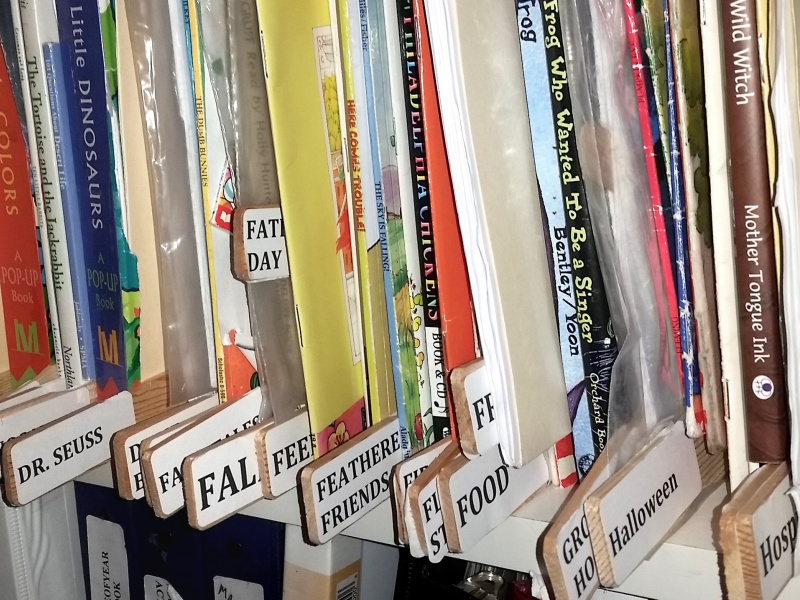
Music In Bloom
In Praise of Organization
by Maureen Conlin
When music is in bloom for all the little ones, chaos is often blossoming out of sight in the closets, basements, shelves, garages, and other spaces where we store the puppets, books, creative movement props, musical instruments, and sound equipment needed to implement our programs. There are a lot of bells and whistles that go into our early childhood music making, and creating organized systems for managing our props can be one of our biggest challenges. Without these systems in place, managing “stuff” can overshadow our real work, which is to encourage young children to explore, imagine, create, and move through music. For those of us who travel from room to room, center to center, or school to school and have to “grab and go” with all our equipment, here are a few ways I keep organized.
Books
Organize books on bookshelves by category. Painted stirring sticks, purchased at a home improvement store for a dollar or less, are a great way to categorize the books in your inventory. I suggest that you purchase a label maker and label each side of the paint stick with a particular category. The Brother PT-D400 label maker is sturdy, efficient, and easy to use, especially if you use it regularly for business.

Place the sticks in alphabetical order between the different categories of books, e.g., animals, dinosaurs, holidays. The paint stirrers extend a few inches beyond the book spines and make it easy to find what you are looking for.
Instruments
One section of my storage shelving is dedicated exclusively to musical instruments. Instruments are stored in clear bins and labeled as well as organized by category. Xylophones are placed together, egg and fruit shakers are in another bin, wood blocks in yet another, and instruments used with toddlers and babies in another. I have an assortment of hand drums stored in a container that I can transport from class to class.

A pegboard can also help to keep you organized and can be purchased inexpensively at your local home improvement store. Purchase brackets and hang musical instruments for easy visibility and use.
Puppets
Organize puppets in large see-through containers and label each container indicating the type of puppets, e.g., farm animals, people, zoo animals, dinosaurs. That way, the right puppets are easily accessible when needed. I hang empty canvas bags on a rack close by so that when I’m packing to go to a school I can transition the puppets into the bag and into my car.

Movement Props
Colorful scarves and stretchy bands can be stored in new, empty paint cans along with a file card of ideas and songs to be used with these creative movement props. Paint cans are available to purchase at local home improvement stores in the paint aisle. Children enjoy the drama and suspense of watching as you open the paint cans and share the contents with them!
Costumes
Purchase garment bags or use a rolling rack for costumes you might wear during Halloween or other holidays, or when highlighting seasons, classroom themes, or music from another country. Over the years I’ve collected a large assortment of hats for different occasions, and clip hangers to store the hats so that they don’t get smashed in a bin or closet.
Sheet Music and Lyrics
Insert sheet music and lyrics into non-glare sheet protectors and place them in binders, labeled for easy access and use. I use binders for specific topics such as “nature’s music,” “bug songs,” “Christmas music,” “harvest time,” and “summer songs.” When each season or class theme comes around, songs and ideas are at my fingertips.
Playlists and CDs
Keeping a playlist of songs that I use for specific themes or levels of classes is also helpful in keeping me organized. Constructing playlists on iTunes is a wonderful tool that keeps your music organized and readily available. Some examples of these song collections include parachute play, bean bags, and movement songs. My “February Friendship” playlist contains songs about love and friendship alphabetically organized.
My collection of CDs is organized in a similar fashion: all the CDs are a bin with drawers, organized alphabetically by artist and/or style of music, and separated by labeled index cards.
Extras
I use duffle bags to store the wires and connectors and miscellaneous items needed for sound equipment. I also keep a small pouch inside the bag for extra batteries, scissors, tape, and extension cords that might be needed at a performance.

Make Organization a Habit
I must emphasize that none of these suggestions will work unless you follow through and commit to forming new habits! Research shows it takes twenty-one days (or more) to form a new habit—but the end result is well worth it.
Remember these important elements:
- Have a designated home and/or system for your materials.
- Store your materials by category (creative movement props together, musical instruments together, puppets together, etc).
- Do not drop your props in a “parking lot” of miscellaneous items.
- When cleaning up or unpacking, keep each item in your hand going to its final destination (home).
- Remember it takes seconds to return a prop to its home, but hours to find it in the parking lot later.
- A system is only as good as the creator and manager. There is no substitute for good habits, resolve, and the conscious effort to make the system work.
Happy organizing and happy singing!